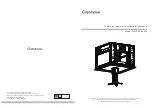
Internal Modules
190
SPRUHI7A – December 2012 – Revised June 2016
Copyright © 2012–2016, Texas Instruments Incorporated
High-Definition Video Processing Subsystem (HDVPSS)
1.2.10.4 Configuration Examples
1.2.10.4.1 Example of 16-Channel Use Case
For example, when NF is used to process 16 channels, the steps below show how we should configure for
channel 12.
Frame 0, Initialization:
1. nf_video_index = 12
2. nf_frame_noise_init_en=1
3. Initialize NF_REG8 and NF_REG9 (Frame_noise_y, Frame_noise_u, Frame_noise_v) with the desired
initialization values.
4. nf_frame_noise_update_en =1
Complete frame processing (the steps 1, 2, and 3 above are used to set the initialization values for noise
measurement, and step 4 means the measured noise value per field/frame will be updated through the IIR
filter.)
Clear the initialization flags at Frame 1:
nf_frame_noise_init_en=0
At this point, to read the measured noise levels:
Set frame_noise_read_index = 12
Read stored Frame_noise_y/u/v through NF_Reg8 and Reg9
1.2.10.4.2 Basic Configurations
NF can be easily configured to perform spatial-temporal filtering, spatial-only filtering, temporal-only
filtering, or at by-pass mode.
shows how NF should be configured for each basic mode. Note
that the temporal bypass mode here is mainly used for debug purpose, and it is not a true bypass mode.
Table 1-66. NF Configuration for Each Basic Mode
Register Name
Spatial-Temporal
Spatial Only
Temporal Only
Spatial Bypass
Temporal Bypass
nf_en
1
1
1
1
1
nf_ref_cfg
b’00
Any value, but
preferred to set as
b‘10 or b‘11 to
disable DMA for
reference frame
b’00
Any value, but
preferred to set as
b‘10 or b‘11 to
disable DMA for
reference frame
b’00
nf_bypass_cfg
b’00
b’00
b’00
b’01 (or b‘11)
b’10
spatial_strength X 6
0
temporal_strength
0
















































